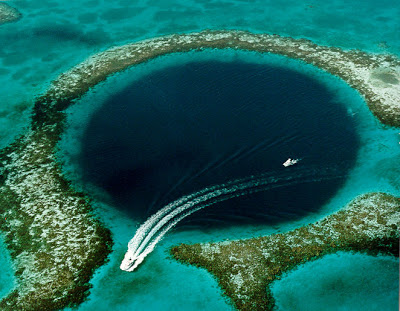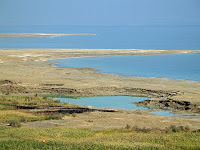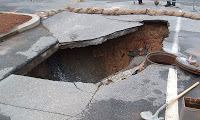
A sinkhole, also known as a sink-hole, sink, swallow hole, shakehole, swallet or doline, is a natural depression or hole in the Earth’s surface which may have various causes. Some are caused by karst processes—for example, the chemical dissolution of carbonate rocks or suffosion processes in sandstone. Others are formed as a result of the collapse of old mine workings close to the surface.
\Sinkholes may vary in size from 1 to 600 m (3.3 to 2,000 ft) both in diameter and depth, and vary in form from soil-lined bowls to bedrock-edged chasms. Sinkholes may be formed gradually or suddenly, and are found worldwide. The different terms for sinkholes are often used interchangeably.
Formation
Natural processes
Sinkholes may capture surface drainage from running or standing water, but may also form in high and dry

places in certain locations.
The formation of sinkholes involves natural processes of erosion or gradual removal of slightly soluble bedrock (such as limestone) by percolating water, the collapse of a cave roof, or a lowering of the water table. Sinkholes often form through the process of suffosion. Thus, for example, groundwater may dissolve the carbonate cement holding the sandstone particles together and then carry away the lax particles, gradually forming a void.
Occasionally a sinkhole may exhibit a visible opening into a cave below. In the case of exceptionally large sinkholes, such as the Minyé sinkhole in Papua New Guinea or Cedar Sink at Mammoth Cave National Park in Kentucky, an underground stream or river may be visible across its bottom flowing from one side to the other.
Sinkholes are common where the rock below the land surface is limestone or other carbonate rock, salt beds, or other rocks that can naturally be dissolved by circulating ground water. As the rock dissolves, spaces and caverns develop underground. These sinkholes can be dramatic, because the surface land usually stays intact until there is not enough support. Then, a sudden collapse of the land surface can occur.
Artificial processes
Sinkholes also form from human activity, such as the rare but still occasional collapse of abandoned mines

and salt cavern storage in salt domes in places like Louisiana, Mississippi and Texas. More commonly, sinkholes occur in urban areas due to water main breaks or sewer collapses when old pipes give way. They can also occur from the overpumping and extraction of groundwater and subsurface fluids.
Sinkholes can also form when natural water-drainage patterns are changed and new water-diversion systems are developed. Some sinkholes form when the land surface is changed, such as when industrial and runoff-storage ponds are created; the substantial weight of the new material can trigger an underground collapse of supporting material, thus causing a sinkhole.
Occurrence
The most impressive sinkholes form in thick layers of homogenous limestone. Their formation is facilitated by high groundwater flow, often caused by high rainfall; such rainfall causes formation of the giant sinkholes in Nakanaï Mountains, on the New Britain island in Papua New Guinea. On the contact of limestone and insoluble rock below it, powerful underground rivers may form, creating large underground voids.In such conditions the largest known sinkholes of the world have formed, like the 662-metre (2,172 ft) deep Xiaozhai Tiankeng (Chongqing, China), giant sótanos in Querétaro and San Luis Potosí states in Mexico and others.
Unusual processes have formed the enormous sinkholes of Sistema Zacatón in Tamaulipas (Mexico), where more than 20 sinkholes and other karst formations have been shaped by volcanically heated, acidic groundwater. This has produced not only the formation of the deepest water-filled sinkhole in the world—Zacatón—but also unique processes of travertine sedimentation in upper parts of sinkholes, leading to sealing of these sinkholes with travertine lids.The state of Florida in the United States is known for having frequent sinkhole collapses, especially in the central part of the state. The Murge area in southern Italy also has numerous sinkholes. Sinkholes can be formed in retention ponds from large amounts of rain.
Local names of sinkholes










